
Moa are an extinct group of flightless birds formerly endemic to New Zealand. During the Late Pleistocene-Holocene, there were nine species. The two largest species, Dinornis robustus and Dinornis novaezelandiae, reached about 3.6 metres (12 ft) in height with neck outstretched, and weighed about 230 kilograms (510 lb) while the smallest, the bush moa, was around the size of a turkey. Estimates of the moa population when Polynesians settled New Zealand circa 1300 vary between 58,000 and approximately 2.5 million.

The Auckland Island merganser, also known as the New Zealand merganser, was a typical merganser that is now extinct.
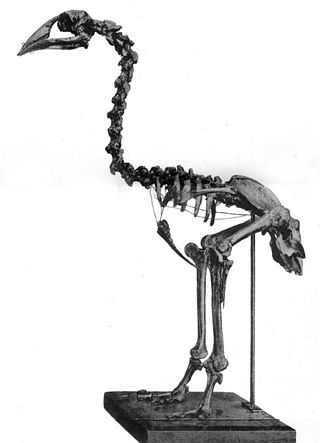
The adzebills, genus Aptornis, were two closely related bird species, the North Island adzebill,, and the South Island adzebill,, of the extinct family Aptornithidae. The family was endemic to New Zealand. A tentative fossil species,, is known from the Miocene Saint Bathans fauna.

The upland moa is an extinct species of moa that was endemic to New Zealand. It is a ratite, a grouping of flightless birds with no keel on the sternum. It was the last moa species to become extinct, vanishing around 1500 CE, and was predominantly found in alpine and sub-alpine environments.

The New Zealand raven was native to New Zealand, but has been extinct since the 16th century. There were three subspecies: the North Island raven, South Island raven, and Chatham raven from the Chatham Islands.

The eastern moa is an extinct species of moa that was endemic to New Zealand.
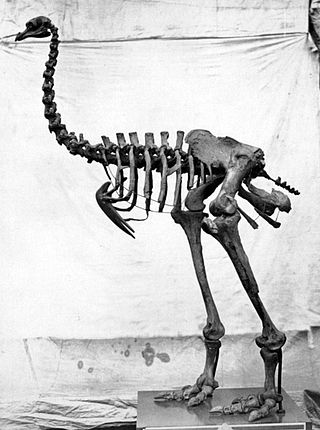
Pachyornis is an extinct genus of ratites from New Zealand which belonged to the moa family. Like all ratites it was a member of the order Struthioniformes. The Struthioniformes are flightless birds with a sternum without a keel. They also have a distinctive palate. This genus contains three species, and are part of the Anomalopteryginae or lesser moa subfamily. Pachyornis moa were the stoutest and most heavy-legged genus of the family, the most notable species being Pachyornis elephantopus - the heavy-footed moa. They were generally similar to the eastern moa or the broad-billed moa of the genus Euryapteryx, but differed in having a pointed bill and being more heavyset in general. At least one species is assumed to have had a crest of long feathers on its head. The species became rapidly extinct following human colonization of New Zealand, with the possible exception of P. australis, which may have already been extinct by then - although the most recent moa skeleton ever described is a partial skeleton of this species, radiocarbon dated to between 1396 and 1442.
The long-billed wren is an extinct species of New Zealand wren formerly endemic to the South Island of New Zealand. It was the only species in the genus Dendroscansor. It shares the name "long-billed wren" with the Brazilian bird Cantorchilus longirostris.

Finsch's duck was a large terrestrial species of duck formerly endemic to New Zealand. The species was possibly once the most common duck in New Zealand, a supposition based on the frequency of its fossils in bone deposits.
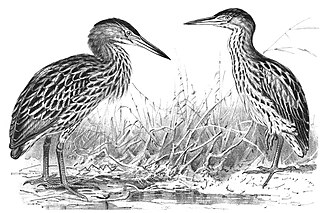
The New Zealand bittern is an extinct and enigmatic species of heron in the family Ardeidae. It was endemic to New Zealand and was last recorded alive in the 1890s.

Forbes's snipe is an extinct species of New Zealand snipe formerly endemic to the Chatham Islands. It was the larger of two species found there, the smaller being the surviving Chatham snipe. It was never seen alive by scientists and is known only from fossil material collected on the islands. Why it became extinct while its smaller relative survived is a mystery, as is the exact timing of its extinction, although it may have survived, unnoticed, until the 15th century.
Scarlett's duck is an extinct duck species from New Zealand which was closely related to the Australian pink-eared duck. The scientific name commemorates the late New Zealand ornithologist and palaeontologist Ron Scarlett who discovered the holotype in 1941. However, previously undescribed bones of the species found in 1903 were rediscovered in the Otago Museum in 1998. At least 32 fossil remains from deposits in Pyramid Valley, at Ngāpara in the South Island, and at Lake Poukawa in the North Island are in museum collections.

The crested moa is an extinct species of moa. It is one of the 9 known species of moa to have existed.

The heavy-footed moa is a species of moa from the lesser moa family. The heavy-footed moa was widespread only in the South Island of New Zealand, and its habitat was the lowlands. The moa were ratites, flightless birds with a sternum without a keel. They also have a distinctive palate. The origin of these birds is becoming clearer as it is now believed that early ancestors of these birds were able to fly and flew to the southern areas in which they have been found.

The North Island giant moa is an extinct moa in the genus Dinornis, known in Māori as kuranui. Even though it might have walked with a lowered posture, standing upright, it would have been the tallest bird ever to exist, with a height estimated up to 3.6 metres (12 ft).

The South Island giant moa is an extinct species of moa in the genus Dinornis, known in Māori by the name moa nunui. It was one of the tallest-known bird species to walk the Earth, exceeded in weight only by the heavier but shorter elephant bird of Madagascar.
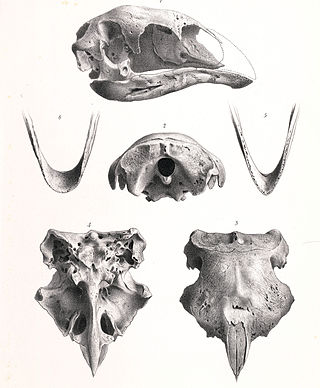
The broad-billed moa, stout-legged moa or coastal moa is an extinct species of moa that was endemic to New Zealand.
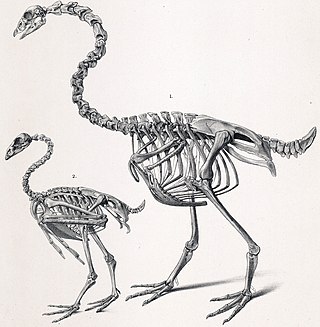
The New Zealand goose is a bird of the extinct genus Cnemiornis of the family Anatidae, subfamily Anserinae. The genus, endemic to New Zealand, consisted of two species: the North Island goose, C. gracilis and the South Island goose C. calcitrans.
Scarlett's shearwater is an extinct species of seabird in the petrel family Procellariidae. Its common name commemorates New Zealand palaeontologist Ron Scarlett, who recognised the bird's subfossil remains represented a distinct species.

The New Zealand musk duck, also known as de Lautour's duck, is an extinct stiff-tailed duck native to New Zealand. It is only known from subfossil bones. It was 10 percent larger than its closest living relative, the Australian musk duck Biziura lobata, with which it has sometimes been combined.




















